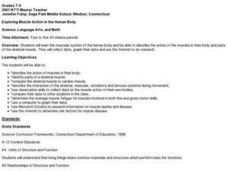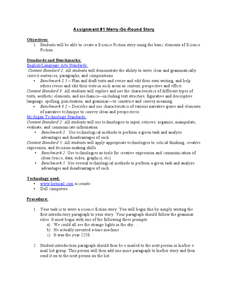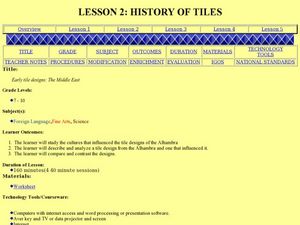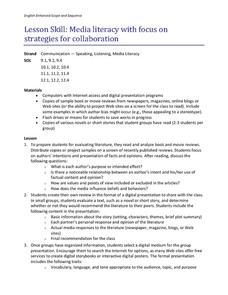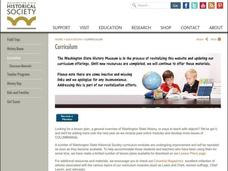Curated OER
Folk Dances from Spanish Speaking Countries
Students explore dance activities from three different Spanish speaking countries.
Curated OER
Exploring Muscle Action in the Human Body
Students collect and graph data and use the internet to research the skeletal muscles.
Curated OER
Natural Resources Product Booklet
Middle schoolers conduct a research activity and create a base product booklet that helps them recognize the resources that are available to them from the natural resources in the area that they live in.
Curated OER
Making the Most of the Internet
Children listen as the teacher tells them about Childnet. Students use the CD-ROM and internet sites to answer questions on the worksheets. Students learn to navigate the sites and search techniques. If time and interest allows, an...
Curated OER
Assignment # 1: Merry-Go-Round Story
Class members use e-mail and the merry-go-round story format to create a science fiction story. Each writer begins by selecting one of three prompts, crafting the introductory paragraph and sending the paragraph to the next person on the...
Curated OER
Show Me The Money
Third graders explore the value of U.S. money. In this money lesson, 3rd graders print out pictures of money from the Internet and create play money. The students will play a game in which they display the amount of money called out by...
Curated OER
Immigration Connections: The Squamish Nation and Bainbridge Island Filipino Americans
High schoolers explore ancestry and immigration. In this Canadian immigration lesson, students interview their family members to identify their cultural history. They compose an essay that compares Filipino immigration stories to those...
Alabama Learning Exchange
Origami Geometry
Origami is an excellent way to combine Japanese culture, art, and geometric shapes into one engaging instructional activity! Scholars begin by listening to the story Sadako and the Thousand Paper Cranes and learn the origin of...
Curated OER
A New You!
Science learners journal familiar ways that the human body can regenerate or heal itself. In small groups, they research and create a poster of current information on stems cells and how they can be used to regenerate. The article for...
Curated OER
Marine Animals on the Move
Young scholars work with partners to track tagged animals using real-time data from satellites. Students gather and analyze data, compile information and conclusions and then prepare a final presentation of their research.
Curated OER
Passport to Africa
Young scholars begin the instructional activity by reading a novel about the diversity of geography in Africa. They are to create an oral report based on information they research. They also communicate with someone through email about...
Curated OER
Edit Essays with Word Tables
Students examine how to identify grammar and spelling errors in an essay using the features of Word after the teacher uses the highlight feature. They correct the errors using Word's table feature by making a table that shows the error...
Curated OER
Citing Sources
Students explore the purpose and requirements for a bibliography. They examine where to find bibliographic information in a variety of print and non-print sources on an assigned topic. Students prepare a bibliography online using a...
Curated OER
History of Tiles: Early Tile Designs - The Middle East
Students create a presentation on Middle Eastern art. In this art history lesson, students will research Middle Eastern art, specifically focusing on the Alhambra Palace and Moorish-inspired tile design. They will use information...
Curated OER
European Union Governance
Become familiar with the structure and functions of the European Union. As they conduct internet research, young historians use an attached worksheet to categorize the five main institutions of the EU. A flowchart worksheet also gives...
English Enhanced Scope and Sequence
Media Literacy with Focus of Strategies for Collaboration
Introduce your class to literary analysis with a series of activities that has them examine book and movie reviews. Groups then draft their own review of a text, select a digital medium, and craft a presentation.
Curated OER
Endangered Animals in Texas
Students research endangered animal in the library and on the Internet for information on its description, habitat, forces causing its decline, and programs to help it; students create slide show about the animal that contains a clay...
Curated OER
Challenge to Communicate
Students use Lewis and Clark's journals to identify the forms of non-verbal communication they used. They discover the problems they faced on their journey and how they overcame them. They practice using the non-verbal language of the...
Curated OER
Ziplock Chemistry
Students investigate various chemical reactions when creating mixtures in ziplock baggies. In this chemistry lesson, students will recognize various chemical reactions and cite evidence. Safety and assessment strategies are included in...
Curated OER
Drinking and Driving
Students select resources relating to alcohol relate dissues of drinking and driving. They explain the dangers of mixing drinking and driving. Students discuss the dangaer of drinking and driving using notes from Internet investigations....
Curated OER
Nature's Recycling Program
Students identify what materials make up compost. In this science of recycling lesson, students explain the benefits of composting determine how compost is a good plant fertilizer.
Curated OER
National Security; The Rosenbergs, Espionage
Students research the history of Julius and Ethel Rosenberg as a lens through which to consider that cases involving a breach of national security tend to be very complicated. They reflect that problems with national security have...
Curated OER
Asexual versus Sexual Reproduction
Students explore reproduction. They research organisms and groups of organisms to determine whether they reproduce sexually or asexually. In addition, they determine the organism's habitat.
Curated OER
Where I Live…
Second graders explore their community. In this social studies lesson plan, 2nd graders use Internet tools to locate their community on a map and then locate where they live.

